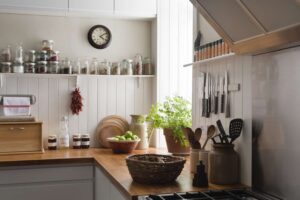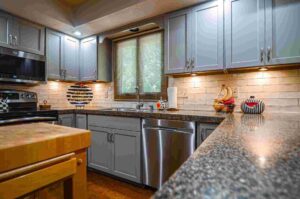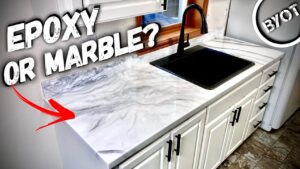Why It’s Worth It to Get a New Backsplash: The backsplash is a small part of your kitchen or bathroom, but it makes a big difference in how the room looks and feels. It keeps your walls clean and safe from spills and splatters, and it’s also a great way to add color, texture, and personality. Although it can be expensive to hire a professional to install tiles, there are many easy, cheap ways to update your backsplash without losing style.
Peel-and-stick tiles make it easy to change things quickly
Peel-and-stick tile is one of the most famous and easy-to-use wall options. These self-adhesive tiles come in a lot of different styles, from classic subway tile to trendy marble and mosaic looks. They are easy to put down and don’t require any glue, special tools, or mess. To put the tile down, just clean the area, peel off the backing, and press it down. You can also rent peel-and-stick tiles because many of them are easy to take off and won’t damage the wall.
Painted backsplash for a bright new look
Painting your wall is a great choice for a simple, low-cost way to add color or design. Use a bright color and high-quality washable paint to make your room stand out. To add more depth or interest, you could use cutouts to make designs that look like tiles. You can make cheap tiles look like pricey ones with painter’s tape, a sponge brush, and some imagination.
For a classic look, use beadboard panels
Beadboard is a lovely, inexpensive material that gives any kitchen or bathroom a cute, cottage-style look. Beadboard pieces are easy to cut and put up with construction glue or finishing nails. You can find them at most home improvement shops. Once in place, apply a coat of paint in a color that complements your cabinets or counters to complete the look. You can’t go wrong with this if you want a classic, farmhouse-style look.
For a rustic look, use fake brick or stone
Faux brick or stone walls, which are significantly less expensive than their real counterparts, can impart a rough, textured aesthetic to a room. These panels are thin, easy to cut, and usually come in patterns that fit together perfectly for a smooth fitting. This DIY wall choice looks great and lasts a long time. You can give it a modern loft vibe with painted brick or a cozy cabin vibe with stone. Combine it with mechanical or wood components for a cohesive design.
For a smooth look, use laminate or vinyl sheets
Large laminate or vinyl sheets made to be stuck on the wall are a stylish, water-resistant option that is also easy to clean. You can cut these sheets to size and glue them right to the wall to make a smooth, continuous surface. They come in many shapes and textures, such as prints of granite, marble, and tiles, so it’s easy to get the look you want without spending a lot of money.
Retro Ceiling Tiles Made of Tin
Putting tin ceiling tiles to use as a backsplash gives your room a vintage look. You can easily cut these light metal tiles to size with tin snips, and you can use glue or nails to connect them to the wall. They shine if left alone, or you can paint them to match your kitchen. Their special roughness and shiny surface can also make dark or small rooms brighter.
Use chalkboard paint to make your backsplash work
Consider a chalkboard paint border if you want to do something fun and artistic. This concept works really well in little rooms or eating places. Chalkboard paint transforms an ordinary wall into a writing surface, enabling you to jot down to-do lists, recipes, or daily events. Pick black for a strong contrast or colored chalkboard paint for a fun change. This is a great idea for families with kids who like to draw.
For warmth, use wooden planks or shiplap
Wood makes a room feel warm and cozy right away. Use recycled wood, pallet wood, or pre-cut planks to create a wood border. You can sand, stain, or paint the boards to get the look you want, then use glue or pins to connect them to the wall. To protect the wood from water and spills, make sure to use a waterproof sealer. For a clean, modern country look that works in both kitchens and laundry rooms, shiplap is a great choice.
Mirror tiles make a room look sleek and airy
If you put mirror tiles on your floor, they will reflect light and make a small room feel bigger. Most mirror tiles are cheap and easy to put in place with building glue. Modern kitchens look great with this style. It gives the room a modern, high-end feel without the high-end price tag. As long as you keep them clean, they will look their best.
Putting fabric behind Plexiglass or glass
If you want a truly unique and flexible wall, you could put colorful cloth behind a piece of glass or plastic. Pick a design, either big or small, and put the clear sheet on top of it to protect it from spots and spills. You can easily change the fabric when you want a new look, and this method gives you a lot of style choices. This method makes it easy to add a personal touch to your room without spending a lot of money.
For a unique finish, mix and match materials
Is it necessary to limit yourself to just one option? Mixing different colors and textures can help you make a unique tile design. Put peel-and-stick tiles on one wall and beadboard on the other. Alternatively, you can combine pieces that resemble subway tiles with a strip of artistic trim or border tiles. Not only does mixing materials make things look more interesting, but it also helps you save money by only using high-end finishing in key areas.
Style doesn’t have to cost a lot of money
You can make a stylish and useful border without spending a lot of money or hiring a professional. With some imagination, the right tools, and some extra time on the weekend, you can use one of these simple, low-cost ideas to make your kitchen or bathroom look brand new. You can make a border that fits your style and level of skill, whether you like things to look clean and modern or warm and rural. These improvements not only keep your walls safe, but they also make the heart of your home more unique and warm.
Questions and Answers (FAQ):
Q1: How can I do a border for the least amount of money?
Some of the cheapest things you can do yourself are peel-and-stick tiles, painting borders, and beadboard panels. These products don’t cost much, are simple to put up, and don’t require many tools or skills.
Q2: Can I put up a border without taking down the one I have now?
As long as the old border is clean, dry, and smooth, you can put down peel-and-stick tiles, beadboard, or even laminate sheets right on top of it. Always make sure the area is ready for the glue to stick well.
Question 3: Do peel-and-stick wall tiles last a long time?
Some peel-and-stick tiles, like those made of plastic or metal, can last a long time. Water and heat do not damage them, and they perform well in low-traffic areas such as tops. However, in high-heat areas such as behind stoves, these materials may not last as long as regular tile.
Q4: Is it okay to use wood as a kitchen backsplash?
Of course, but you should seal the wood with a waterproof finish to keep water and dirt from getting in. Place wood near cleaned or sealed sinks and stoves to extend its lifespan.
Q5: How do I clean a border that I made myself?
A wet cloth and gentle soap can be used to clean most do-it-yourself countertops, like painting walls, vinyl tiles, and wood that has been finished. Don’t use strong chemicals on surfaces that are painted or peel-and-stick because they can damage the finish.
Question 6: Can I put up a wall in a rental home?
Of course. People who rent should use peel-and-stick tiles, fabric behind plastic, and light pieces like beadboard or foam. These are great for short changes because they can usually be taken down without hurting the wall.
Q7: How long does it take to put up a border that you make yourself?
You can do most wall jobs yourself in just one weekend or less. It may only take a few hours to do simple things like peel-and-stick or whiteboard paint, based on how big the area is.
Q8: What do I need to do a wall project myself?
A utility knife, measuring tape, level, pencil, scissors, glue, and maybe even a caulking gun are some of the basic tools you’ll need for most jobs. Depending on how complicated the material is, you may need extra tools like a saw or a tile maker.



